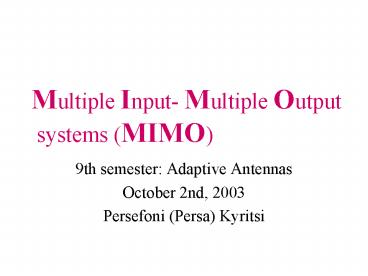Multiple Input Multiple Output systems MIMO - PowerPoint PPT Presentation
1 / 29
Title:
Multiple Input Multiple Output systems MIMO
Description:
x,vK x,vK uK sK x,v1 u1 s1 x,v2 u2 s2. Capacity = sum of capacities ... (Q: constellation size, M: number of transmitters) VERY high complexity! ... – PowerPoint PPT presentation
Number of Views:451
Avg rating:3.0/5.0
Title: Multiple Input Multiple Output systems MIMO
1
Multiple Input- Multiple Output systems (MIMO)
- 9th semester Adaptive Antennas
- October 2nd, 2003
- Persefoni (Persa) Kyritsi
2
Outline
- SISO to MISO/ SIMO to MIMO
- Interpretations of capacity
- Parallel channels
- Directional analysis
- Detection algorithms
- From narrowband to broadband
- High capacity and how to get it
- Practical considerations
- Conclusions
3
Single Input- Single Output systems (SISO)
x(t) transmitted signal y(t) received
signal g(t) channel transfer function n(t)
noise (AWGN, ?2)
g
y(t)
x(t)
- y(t) g x(t) n(t)
Signal to noise ratio Capacity
C log2(1?)
4
Single Input- Multiple Output (SIMO) Multiple
Input- Single Output (MISO)
- Principle of diversity systems (transmitter/
receiver) - Higher average signal to noise ratio
- Robustness
- - Process of diminishing return
- Benefit reduces in the presence of correlation
- Maximal ratio combining gt
- Equal gain combining gt
- Selection combining
5
Idea behind diversity systems
- Use more than one copy of the same signal
- If one copy is in a fade, it is unlikely that all
the others will be too. - C1xNgtC1x1
- C1xN more robust than C1x1
6
Multiple Input- Multiple Output systems (MIMO)
7
Power definitions for MIMO
- Average gain
- Average signal to noise ratio
- Normalized channel transfer matrix
8
Expressions for the Shannon capacity
K rank of H, ui eigenvalues of H
9
Interpretation I The parallel channels approach
- Singular value decomposition of H H SUVH
- S, V unitary matrices (VHVI, SSH I)
- U diag(uk), uk singular values of H
- V/ S input/output eigenvectors of H
- Any input along vi will be multiplied by ui and
will appear as an output along si
10
The math
11
Vector analysis of the signals
- 1. The input vector x gets projected onto the
vis - 2. Each projection gets multiplied by a different
gain ui. - 3. Each appears along a different si.
- Note power conservation
u1
ltx,v1gt
ltx,v1gt u1 s1
u2
ltx,v2gt
ltx,v2gt u2 s2
uK
ltx,vKgt uK sK
ltx,vKgt
12
Capacity sum of capacities
- The channel has been decomposed into K parallel
subchannels - Total capacity sum of the subchannel capacities
- All transmitters send the same power
- ExEk
13
Interpretation II The directional approach
- Singular value decomposition of H H SUVH
- Eigenvectors correspond to spatial directions
(beamforming)
(vi)1
1 M
x
(vi)M
14
Example of directional interpretation
15
Detection algorithms
- Maximum likelihood linear detector
- y H x n ? xest Hy
- H (HH H)-1 HH Pseudo inverse of H
- Problem find nearest neighbor among QM points
- (Q constellation size, M number of
transmitters) - VERY high complexity!!!
16
Solution BLAST algorithm
- BLAST Bell Labs lAyered Space Time
- Idea NON-LINEAR DETECTOR
- Step 1 H (HH H)-1 HH
- Step 2 Find the strongest signal
- (Strongest the one with the highest post
detection SNR) - Step 3 Detect it (Nearest neighbor among Q)
- Step 4 Subtract it
- Step 5 if not all yet detected, go to step 2
17
Discussion on the BLAST algorithm
- Its a non-linear detector!!!
- Two flavors
- V-BLAST (easier)
- D-BLAST (introduces space-time coding)
- Achieves 50-60 of Shannon capacity
- Error propagation possible
- Very complicated for wideband case
18
From narrowband to wideband
- Wideband delay spread gtgt symbol time
- - Intersymbol interference
- Frequency diversity
- SISO channel impulse response
- SISO capacity
19
Matrix formulation of wideband case
20
Equivalent treatment in the frequency domain
- Wideband channel Many narrowband channels
- H(t) ? H(f)
Noise level
f
21
Objective High capacity
- Capacity depends on
- Eigenvalues
- Signal to noise ratio
- Power roll-off depends on the environment
- Rank depends on the scattering
- Distribution of eigenvalues depends on the
correlation
22
For high capacity
Limits Power constraints System size Correlation
- Ideally
- As high gain as possible
- As many eigenvectors as possible
- As orthogonal as possible
23
Example Uncorrelated correlated channels
24
Practical considerations
- Coding
- Detection complexity
- Channel estimation
- Interference
25
Coding limitations
- Capacity Maximum achievable data rate that can
be achieved over the channel with arbitrarily low
probability of error - SISO case
- Constellation limitations
- Turbo- coding can get you close to Shannon!!!
- MIMO case
- Constellation limitations as well
- Higher complexity
- Space-time codes very few!!!!
26
Channel estimation
- The channel is not perfectly estimated because
- it is changing (environment, user movement)
- there is noise DURING the estimation
- An error in the channel transfer characteristics
can hurt you - in the decoding
- in the water-filling
- Trade-off Throughput vs. Estimation accuracy
- What if interference (as noise) is not white????
27
Interference
- Generalization of other/ same cell interference
for SISO case - Example cellular deployment of MIMO systems
- Interference level depends on
- frequency/ code re-use scheme
- cell size
- uplink/ downlink perspective
- deployment geometry
- propagation conditions
- antenna types
28
Extensions
- Optimal power allocation
- Optimal rate allocation
- Space-time codes
- Distributed antenna systems
- Many, many, many more!
29
Summary and conclusions
- MIMO systems are a promising technique for high
data rates - Their efficiency depends on the channel between
the transmitters and the receivers (power and
correlation) - Practical issues need to be resolved
- Open research questions need to be answered































